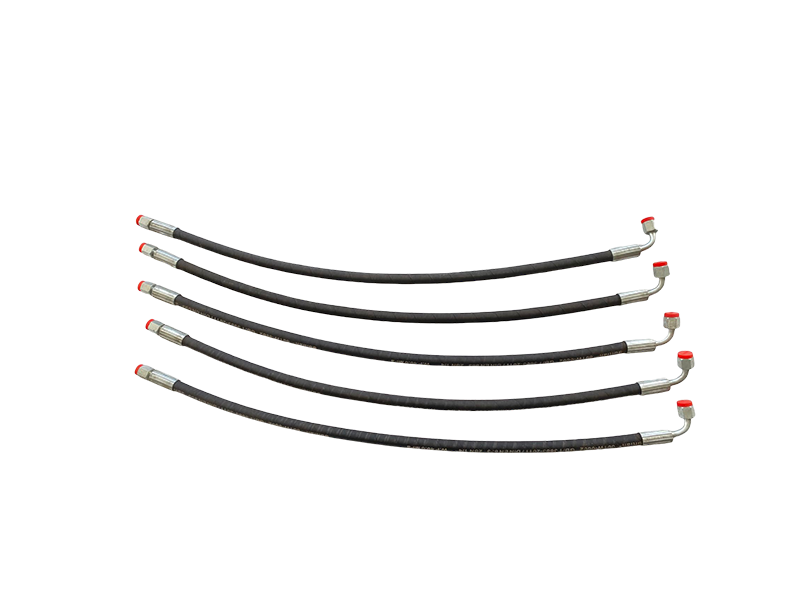news center
Understanding the Different Types of High Pressure Hydraulic Hose Pipes
2023-08-12
Table of Contents:
1. Introduction
2. What are High Pressure Hydraulic Hose Pipes?
3. Types of High Pressure Hydraulic Hose Pipes
3.1. Rubber Hydraulic Hose Pipes
3.2. Thermoplastic Hydraulic Hose Pipes
3.3. Steel Hydraulic Hose Pipes
3.4. Composite Hydraulic Hose Pipes
4. Key Factors to Consider when Choosing Hydraulic Hose Pipes
5. Benefits of Using High-Quality Hydraulic Hose Pipes
6. Frequently Asked Questions (FAQs)
6.1. What are the advantages of rubber hydraulic hose pipes?
6.2. Can I use thermoplastic hydraulic hose pipes in extreme temperatures?
6.3. Are steel hydraulic hose pipes suitable for high-pressure applications?
6.4. How do composite hydraulic hose pipes offer versatility?
6.5. What factors should I consider when selecting hydraulic hose pipes?
7. Conclusion
1. Introduction
In today's industrial world, hydraulic systems play a crucial role in various applications. Understanding the different types of high-pressure hydraulic hose pipes is essential to ensure the optimal performance and safety of these systems. This article aims to provide a comprehensive overview of the various types of hydraulic hose pipes available, empowering you to make informed decisions.
2. What are High Pressure Hydraulic Hose Pipes?
High-pressure hydraulic hose pipes are essential components of hydraulic systems that transmit fluid power from one component to another. They are designed to handle extreme pressure and ensure the smooth and efficient operation of hydraulic machinery. These hoses are constructed using different materials and have unique features to suit specific applications.
3. Types of High Pressure Hydraulic Hose Pipes
3.1. Rubber Hydraulic Hose Pipes
Rubber hydraulic hose pipes are widely used in hydraulic systems due to their flexibility, durability, and resistance to high temperatures. They can withstand a wide range of fluids and are suitable for both low and high-pressure applications. This type of hose is commonly used in construction, agriculture, and industrial machinery.
3.2. Thermoplastic Hydraulic Hose Pipes
Thermoplastic hydraulic hose pipes are known for their lightweight and flexible nature. They offer excellent resistance to chemicals, abrasion, and UV radiation. These hoses are suitable for applications that require low temperature flexibility and are commonly used in material handling, aerial lift equipment, and hydraulic jacks.
3.3. Steel Hydraulic Hose Pipes
Steel hydraulic hose pipes are designed to handle extremely high-pressure applications. These hoses are constructed with multiple layers of steel wire braids, providing excellent strength and durability. They are commonly used in heavy machinery, construction equipment, and oil and gas industries.
3.4. Composite Hydraulic Hose Pipes
Composite hydraulic hose pipes combine the advantages of different materials to offer versatility and durability. They are constructed with a combination of thermoplastic, rubber, and textile reinforcement layers. These hoses are suitable for applications that require resistance to chemicals, extreme temperatures, and heavy-duty usage.
4. Key Factors to Consider when Choosing Hydraulic Hose Pipes
When selecting hydraulic hose pipes, it is essential to consider factors such as pressure rating, temperature range, compatibility with fluids, flexibility, and bend radius. Additionally, factors like abrasion resistance, length, and cost should also be taken into account to ensure optimal performance and longevity.
5. Benefits of Using High-Quality Hydraulic Hose Pipes
Using high-quality hydraulic hose pipes provides numerous benefits, including improved system performance, increased productivity, enhanced safety, and reduced maintenance costs. These hoses offer reliable fluid power transmission, withstand harsh operating conditions, and minimize the risk of system failure or downtime.
6. Frequently Asked Questions (FAQs)
6.1. What are the advantages of rubber hydraulic hose pipes?
Rubber hydraulic hose pipes offer flexibility, durability, and resistance to high temperatures, making them suitable for a wide range of applications.
6.2. Can I use thermoplastic hydraulic hose pipes in extreme temperatures?
Yes, thermoplastic hydraulic hose pipes are designed to withstand extreme temperatures and offer excellent low-temperature flexibility.
6.3. Are steel hydraulic hose pipes suitable for high-pressure applications?
Yes, steel hydraulic hose pipes are specifically designed to handle extremely high-pressure applications, providing excellent strength and durability.
6.4. How do composite hydraulic hose pipes offer versatility?
Composite hydraulic hose pipes combine different materials to offer resistance to chemicals, extreme temperatures, and heavy-duty usage, making them suitable for a variety of applications.
6.5. What factors should I consider when selecting hydraulic hose pipes?
Key factors to consider include pressure rating, temperature range, compatibility with fluids, flexibility, bend radius, abrasion resistance, length, and cost.
7. Conclusion
In conclusion, understanding the different types of high-pressure hydraulic hose pipes is crucial for selecting the right hose for your specific application. Rubber, thermoplastic, steel, and composite hose pipes each offer unique features and benefits that cater to different needs. By considering key factors and choosing high-quality hose pipes, you can ensure the optimal performance and longevity of your hydraulic systems.
1. Introduction
2. What are High Pressure Hydraulic Hose Pipes?
3. Types of High Pressure Hydraulic Hose Pipes
3.1. Rubber Hydraulic Hose Pipes
3.2. Thermoplastic Hydraulic Hose Pipes
3.3. Steel Hydraulic Hose Pipes
3.4. Composite Hydraulic Hose Pipes
4. Key Factors to Consider when Choosing Hydraulic Hose Pipes
5. Benefits of Using High-Quality Hydraulic Hose Pipes
6. Frequently Asked Questions (FAQs)
6.1. What are the advantages of rubber hydraulic hose pipes?
6.2. Can I use thermoplastic hydraulic hose pipes in extreme temperatures?
6.3. Are steel hydraulic hose pipes suitable for high-pressure applications?
6.4. How do composite hydraulic hose pipes offer versatility?
6.5. What factors should I consider when selecting hydraulic hose pipes?
7. Conclusion
1. Introduction
In today's industrial world, hydraulic systems play a crucial role in various applications. Understanding the different types of high-pressure hydraulic hose pipes is essential to ensure the optimal performance and safety of these systems. This article aims to provide a comprehensive overview of the various types of hydraulic hose pipes available, empowering you to make informed decisions.
2. What are High Pressure Hydraulic Hose Pipes?
High-pressure hydraulic hose pipes are essential components of hydraulic systems that transmit fluid power from one component to another. They are designed to handle extreme pressure and ensure the smooth and efficient operation of hydraulic machinery. These hoses are constructed using different materials and have unique features to suit specific applications.
3. Types of High Pressure Hydraulic Hose Pipes
3.1. Rubber Hydraulic Hose Pipes
Rubber hydraulic hose pipes are widely used in hydraulic systems due to their flexibility, durability, and resistance to high temperatures. They can withstand a wide range of fluids and are suitable for both low and high-pressure applications. This type of hose is commonly used in construction, agriculture, and industrial machinery.
3.2. Thermoplastic Hydraulic Hose Pipes
Thermoplastic hydraulic hose pipes are known for their lightweight and flexible nature. They offer excellent resistance to chemicals, abrasion, and UV radiation. These hoses are suitable for applications that require low temperature flexibility and are commonly used in material handling, aerial lift equipment, and hydraulic jacks.
3.3. Steel Hydraulic Hose Pipes
Steel hydraulic hose pipes are designed to handle extremely high-pressure applications. These hoses are constructed with multiple layers of steel wire braids, providing excellent strength and durability. They are commonly used in heavy machinery, construction equipment, and oil and gas industries.
3.4. Composite Hydraulic Hose Pipes
Composite hydraulic hose pipes combine the advantages of different materials to offer versatility and durability. They are constructed with a combination of thermoplastic, rubber, and textile reinforcement layers. These hoses are suitable for applications that require resistance to chemicals, extreme temperatures, and heavy-duty usage.
4. Key Factors to Consider when Choosing Hydraulic Hose Pipes
When selecting hydraulic hose pipes, it is essential to consider factors such as pressure rating, temperature range, compatibility with fluids, flexibility, and bend radius. Additionally, factors like abrasion resistance, length, and cost should also be taken into account to ensure optimal performance and longevity.
5. Benefits of Using High-Quality Hydraulic Hose Pipes
Using high-quality hydraulic hose pipes provides numerous benefits, including improved system performance, increased productivity, enhanced safety, and reduced maintenance costs. These hoses offer reliable fluid power transmission, withstand harsh operating conditions, and minimize the risk of system failure or downtime.
6. Frequently Asked Questions (FAQs)
6.1. What are the advantages of rubber hydraulic hose pipes?
Rubber hydraulic hose pipes offer flexibility, durability, and resistance to high temperatures, making them suitable for a wide range of applications.
6.2. Can I use thermoplastic hydraulic hose pipes in extreme temperatures?
Yes, thermoplastic hydraulic hose pipes are designed to withstand extreme temperatures and offer excellent low-temperature flexibility.
6.3. Are steel hydraulic hose pipes suitable for high-pressure applications?
Yes, steel hydraulic hose pipes are specifically designed to handle extremely high-pressure applications, providing excellent strength and durability.
6.4. How do composite hydraulic hose pipes offer versatility?
Composite hydraulic hose pipes combine different materials to offer resistance to chemicals, extreme temperatures, and heavy-duty usage, making them suitable for a variety of applications.
6.5. What factors should I consider when selecting hydraulic hose pipes?
Key factors to consider include pressure rating, temperature range, compatibility with fluids, flexibility, bend radius, abrasion resistance, length, and cost.
7. Conclusion
In conclusion, understanding the different types of high-pressure hydraulic hose pipes is crucial for selecting the right hose for your specific application. Rubber, thermoplastic, steel, and composite hose pipes each offer unique features and benefits that cater to different needs. By considering key factors and choosing high-quality hose pipes, you can ensure the optimal performance and longevity of your hydraulic systems.
关键词
High Pressure Oil Pipe
High Pressure Hard Pipe
High Pressure Hydraulic Hose
Hotline
Add: Changfa Industrial Park, Lijia Town, Wujin District, Changzhou City
Fax: 86-519-8969086
language
English
العربية
বাংলাদেশ
Български
Hrvatski
Česky
Dansk
Nederland
 Esperanto
Esperanto
Slovenski
Filipino
Suomi
Français
Maori
 Shqiptare
Shqiptare
Georgian
 Euskara
Euskara
Deutsch
Ελλάδα
ישראל
इंडिया
Magyarország
Ísland
Indonesia
Irlanda
Italia
日本語
Sovensko
Հայաստան
한국
Kyrgyz
ປະເທດລາວ
 Zulu
Zulu
Latvian
Lithuanian
Luxembourgish
 Latinus
Latinus
Macedonian
Малайская
Maltese
Монгол улс
 Cymraeg
Cymraeg
ဗမာ
 தமிழ்
தமிழ்
नेपाल
Norge
ایران
Polska
Portugal
România
Российская
Србија
 Slovak
Slovak
Србија
 Slovak
Slovak
Bosanski
Slovenian
Беларус
España
Sverige
Точик
ประเทศไทย
Türk
Azərbaycan
Uzbek
 Afrikaans
Afrikaans
Việt Nam
Follow Us

Copyright©2022 Changzhou Guande Machinery Co., Ltd Powered by www.300.cn
Copyright©2022 Changzhou Guande Machinery Co., Ltd
This website already supports IPV6 | SEO | Cloud information



